| 1 | Italy’s most common snake |
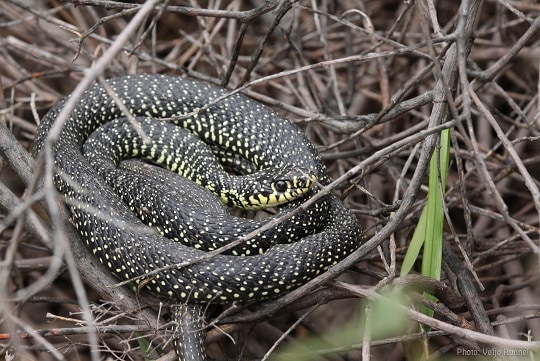
In the USA, the most abundant snake by headcount is the common garter snake (Thamnophis sirtalis). In Britain, the grass snake (Natrix natrix) is the most numerous. In Italy, the land of olives and old Roman ruins, the most common species is the green whipsnake, an energetic, agile species which is slightly venomous and can reach 2 metres.
The green whipsnake inhabits the entirety of Italy (excluding the highest mountains), and is very common within this territory. It’s a very easy species to find, as they often hiss at shocked people before spinning 180 degrees and fleeing into the undergrowth at high speeds. The green whipsnake has never killed anyone, but its aggression levels are approximately 8/10. If picked up, they’ll snap and bite, and wrestle fiercely to escape the humans restraining them. Green whipsnakes are fast slitherers, and often climb high tree branches in order to bask in the warm sunlight.
This Italian snake copes well with many habitats, but their natural realms are dry open areas with an abundance of spiny bushes. The more rocks, the better. Green whipsnakes are attracted both to natural rocks and crumbling manmade structures, such as stone walls, which they often hibernate in.
| 2 | Vicious and snappy |
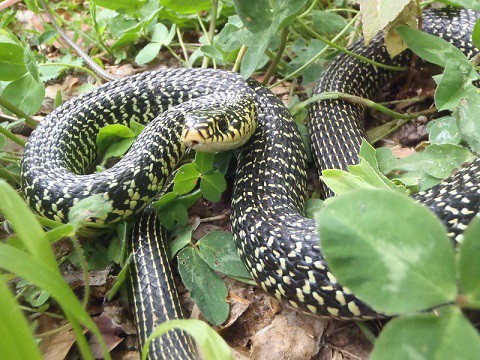
Rather than slow and bulky, green whipsnakes are a slender species with a long tail, which grants them their ninja-like agility. They have large eyes, and males are longer than females, with a slightly wider head.
Green whipsnakes are normally very simple to recognise. Their main colours are yellow-green and black, which are in sharp contrast to each other. The exact proportion of green and black varies wildly, as do the blotches’ shapes. Some are small and leaf-shaped, while others form lines and zigzags. There are hundreds of these lighter blotches on the green whipsnake’s body, like an ultra fine splatter pattern of paint. The higher contrast is what sets this species apart. However, parts of Italy also have a second morph: an unusually black whipsnake where the green is pushed back to a few tiny glimmers.
Southern Italy and Sicily is mainly home to this black morph, but there’s a separate pocket in Italy’s far northeast. These black versions become lighter again when they shed their skin, before the darkening slowly reasserts itself.
| 3 | Crazy Italian folklore |
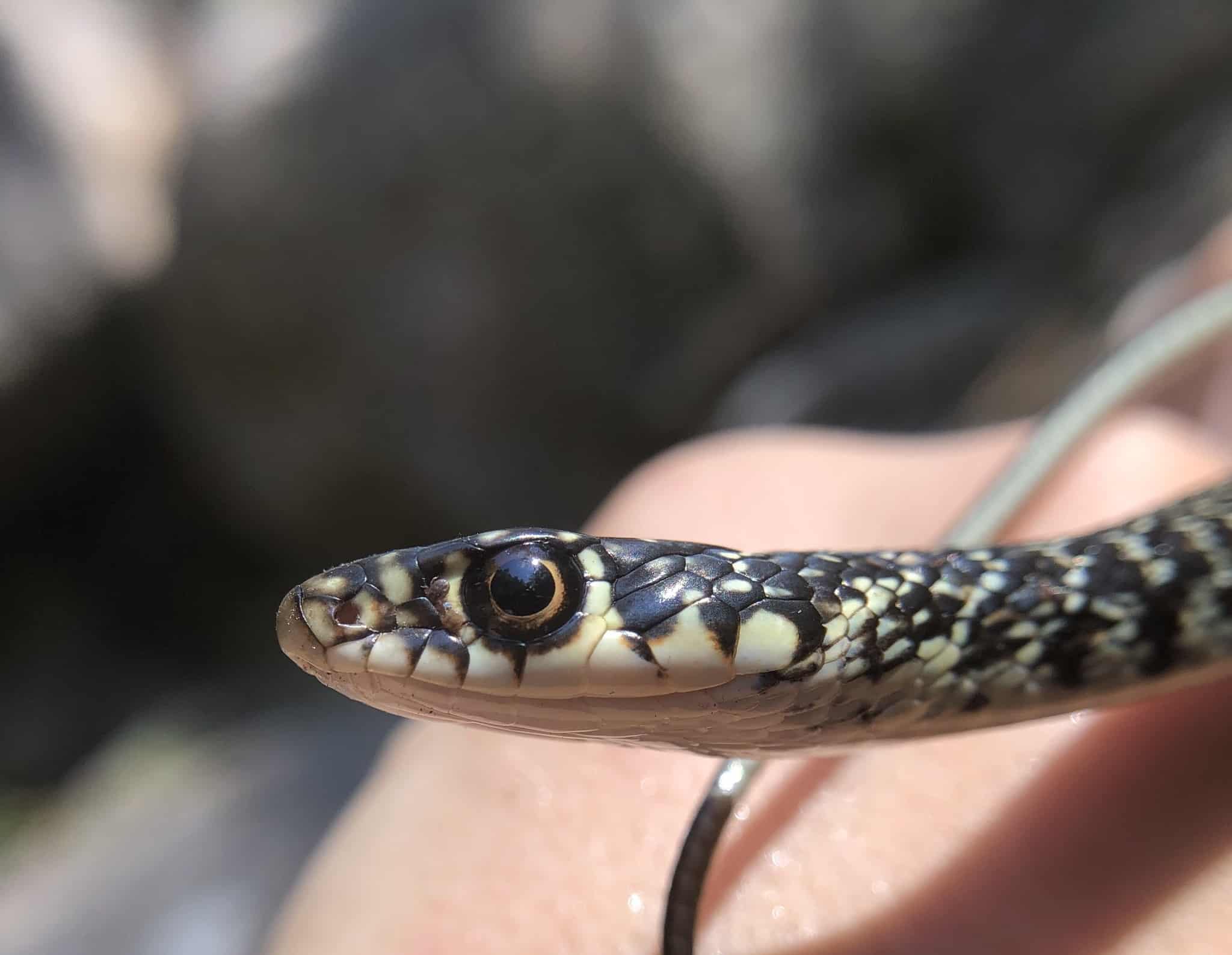
The green whipsnake has dozens of names in rustic villages and farming valleys across Italy. Miroldo is one of the more common names, while in Piedmont it’s called mirauda, and scaebonas in the foothills of the Appenines. Another is bes bastunèr, meaning “snake that strikes”, while other names translate to “rat hunter”. In the bear-infested Trentino region of northern Italy, they’re called carbonaz or carbonazo.
Myths are plentiful, such as them using their long bodies to unleash painful lashes. Supposedly, the worst thing you can do is disturb two green whipsnakes while they’re mating. This can be either accidental or on purpose, maybe while snapping a camera. Even worse is if you cry “il monaco con la monaca”, a traditional phrase which translates to “the nun with the monk!”. This will enrage both male and female snake, and trigger a death-defying pursuit in which you may or may not fall over and be murdered.
| 4 | Venom: mild yet underestimated |

Green whipsnakes are nothing to panic about. However, they’ve recently joined a snake club which has been growing since the year 2000: supposedly non-venomous snakes which turn out to have sneaky toxins. Like the dice snake (also found in Italy), green whipsnakes have a Duvernoy’s gland, which produces venom in a non-traditional way, where the victim must be bitten and chewed for several minutes rather than injected instantly in a lightning cobra strike.
One case involved a drunk beer-lover walking in Landes forest near Bordeaux, with several mates. He spotted a one metre green whipsnake, which he presumed to be dead. The drunk man therefore took the logical decision of wrapping the snake around himself like a necklace. The green whipsnake spent the next minutes nibbling his chest, shoulders and neck, which he was oblivious to.
Finally, his friends warned him, and the drunk guy killed the snake, but 30 minutes later, a wave of symptoms spread up his body: dizziness, muscle weakness, and general malaise. The man fell unconscious, and 3 hours later was placed in intensive care in a Bordeaux hospital. The man also suffered from blurred vision, and a second victim experienced more local symptoms. He was chewed by a green whipsnake for 4-5 minutes, and suffered from edema, tingling, and a skin rash covering his whole hand.
| 5 | Flees cold, loves the heat |
Compared to many snakes, the green whipsnake likes to keep its body at significantly higher temperatures. A 2007 study found that its optimum was 30.8C, +/- 2.4C. Meanwhile, the tiger rattlesnake of Arizona’s Sonoran desert has a target body temperature of 29.5C.
This love of warmth led to a conundrum among scientists – why didn’t the green whipsnake live in Spain except for the far north? There were no habitat requirements blocking them from expanding southwards. The answer is believed to be the Montpellier snake. The two species have much in common. They’re both fast and agile, they both reach 2 metres, and they both charge at their prey while having slightly toxic venom.
It’s believed that these snakes occupy a similar ecological niche, which prevents them from living in any region at the same time without massive competition. The two are entrenched in their empires – Montpellier snakes in Portugal and most of Spain, and the green whipsnake in Italy. If Montpellier snakes tried to conquor Italy, they wouldn’t make it far, and vice versa for the green whipsnake and Spain.
| 6 | The Pyrenees secret |
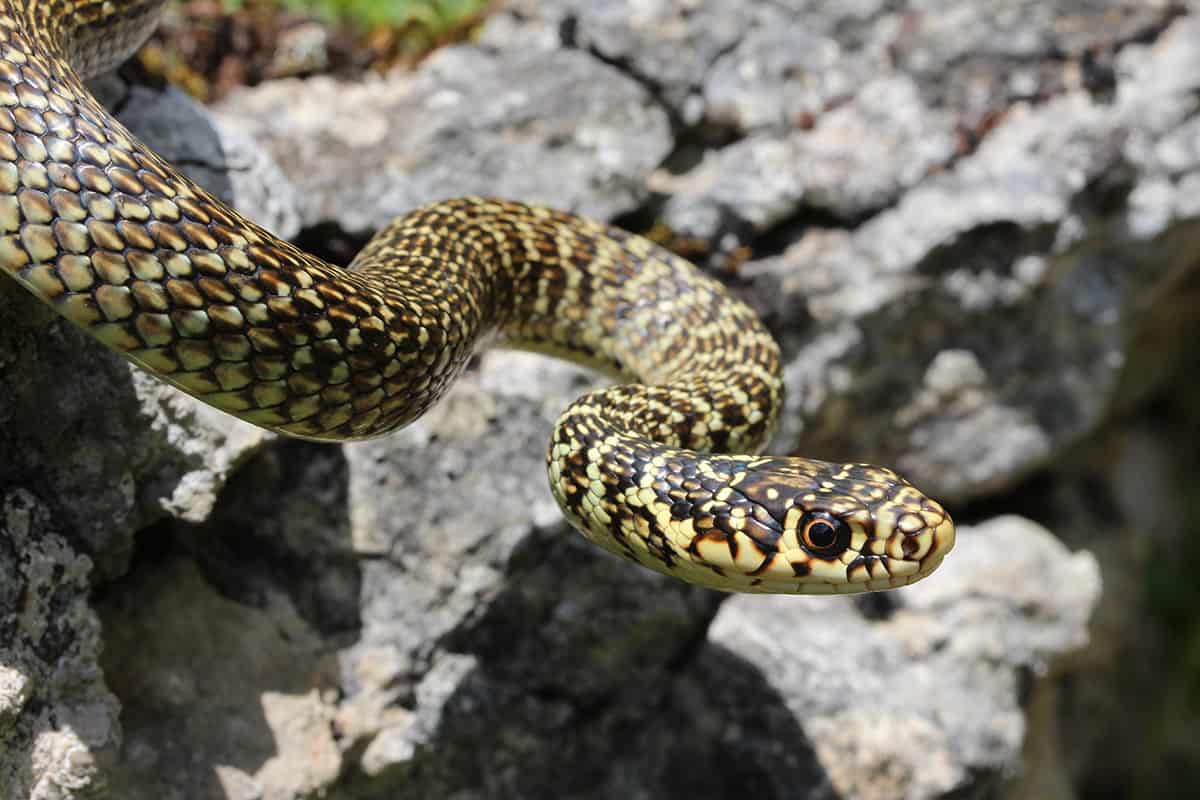
Green whipsnakes are found in open forests like oak groves and pine groves, but rarely thick dense forests. When they do appear in forested regions, it’s almost always along the border or on wide paths.
Green whipsnakes are diurnal (day-faring) rather than nocturnal, and in addition to hunting, their main daily task is prevent their bodies from falling below 30 degrees. Green whipsnakes spend a lot of time basking, and it’s common to find them lying peacefully on thorny bushes during the midday sun.
Their preference for higher temperatures is why green whipsnakes have failed to reach northern France, Britain or Germany. It should also keep them away from high mountains (unlike the meadow viper), but in the Pyrenees, a weird phenomenon has helped them to reach a record altitude of 2200m. The Pyrenees is a thermally active zone, with many natural hot springs which tourists can bathe in. Not all are profitable, and many have closed to the public, but many of the abandoned ones have become refuges for huge swarms of green whipsnakes. In the 1990s, there was even a mass death in Arties, France, when several hundred green whipsnakes became trapped in a man-altered thermal spa with smooth sides. The mountain roads adjacent to these spas are also killing grounds for the snakes.
| 7 | An afternoon snake |
Unlike a blood python, which is most active at dawn and dusk, a green whipsnake prefers the middle of the day. They’re most active from 12:00 to 19:30, particularly on clear warm days.
The green whipsnake has a clear mind, with a strong geographical memory that allows it to recognise certain landmarks. They’re an active snake, with males estimated to move 73.7 metres in an average day, and females 45m. Green whipsnakes go about their business with a special loop system. Loop 1 operates on a one day cycle, and is a sunlight quest used for warming their bodies.
The second loop lasts for 2 or more days, during which green whipsnakes hide in a second refuge. This loop is used for gathering food and exploration. The final loop can last as long as 1 month, and has the purpose of finding females. The distances here can be 3km, after which a green whipsnake can find its old haunts with ease. The green whipsnake can move up to 881 metres in a day.
| 8 | Diet: every location varies |
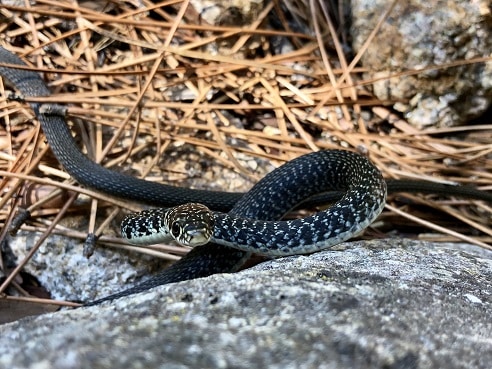
Green whipsnakes ambush occasionally, but most of the time, they take full advantage of the speed and agility given to them by nature. They normally spot a prey, then charge after them at full throttle through the shrubland, probably while licking their lips. They then pounce on the prey and coil around them rapidly, then begin swallowing, reserving their mild venom for larger, trickier animals.
A green whipsnake’s diet is every-varying. They are opportunistic and vary their diet by location. In one field, they could eat lizards exclusively, while on a slope 100 miles away, they could rely on mice. For example, a study in the Tolfa mountains of Central Italy found that most of their diet consisted of common wall lizards (Podcarcis muralis), with a tiny smattering of small mammals. A study from Sicily found that Italian wall lizards (Podarcis sicula), Sicilian wall lizards (Podarcis wagleriana) and ocellated skinks were their top meals, with Sicilian shrews being a secondary staple. However, a Swiss study contradicted this lizard fest: the local green whipsnakes ate 76.1% mammals and 23.9% reptiles. The top species was the wood mouse (Apodemus sylvaticus).
Having huge eyes and moving by day means that green whipsnakes are mainly reliant on vision for hunting, rather than the smell favoured by small-eyed snakes.
| 9 | Follows males to find females |
Sniffing out pheromones produced by females is nothing special for snakes. It was invented 10s of millions of years ago and is clearly old hat by now. However, the green whipsnake has a slightly different strategy – it sniffs out male pheromones, in order to use them as a shortcut to females which it has failed to locate itself. This might seem dishonest, piggy-backing off the harder-working snakes, but green whipsnakes will do all they can to produce the next generation, one way or another.
This is also a snake where males wrestle each other, to establish breeding rights to females. The two males hold their heads upright, not making contact, while their interlocked bodies writhe and twist in a brutal battle to assert dominance. People commonly mistake these warring snakes for a male and female writhing in the passions of love.
Green whipsnakes are egg-layers, and the totals are nothing special, ranging from 3-17. However, females are faithful to the same spot year after year, laying eggs in the same rocky wall or hole in the ground.
| 10 | Still an abundant snake |
Who knows what the next 10 million years will hold, but right now, the green whipsnake is in its prime, like the dinosaurs in the Jurassic era. They’re extremely numerous across Europe, and have an IUCN rating of “least concern”. Outside of Italy, they also inhabit France (excluding the north), southwest Switzerland, the extreme north of Spain, Slovenia and Croatia and Malta. They once inhabited Luxembourg, but they’re believed to be extinct there.
Generally, green whipsnakes eat few amphibians, but in the right spots they’ll happily indulge, particularly islands. This includes Montecristo Island off Italy’s west coast, where one of their staples is the Tyrrhenian painted frog. This is a flexible snake, and another rarity is on Giraglia island, north of Corsica. This is normally a strictly day-daring snake, yet on this island the green whipsnakes go against 99% of their species members and hunt at night. An adaption to local prey on the island is one theory.
Green whipsnakes also have a taste for other snakes, but particularly the venomous asp viper, as shown in a Swiss study. The green whipsnakes here were introduced, and were eating so many asp vipers that the local population was becoming endangered.
